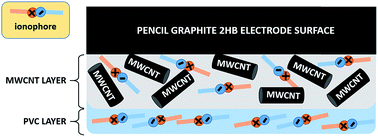Determination of anionic surfactants in real samples using a low-cost and high sensitive solid contact surfactant sensor with MWCNTs as the ion-to-electron transducer
Abstract
Multi-walled carbon nanotubes (MWCNTs) were used as a conducting substrate for construction of an all solid contact anionic surfactant sensor, which used the 1,3-didecyl-2-methylimidazolium–tetraphenylborate (DMI–TPB) ion pair as the sensing element implemented in PVC membranes. Scanning electron microscopy (SEM) and electrochemical impedance spectroscopy (EIS) were used for morphological and electrochemical characterisation of the sensor. The investigated sensor showed a Nernstian response for lauryl sulfate (LS), 57.1 mV per decade of activity between 2.0 × 10−7 and 1.1 × 10−3 M; and a sub-Nernstian response for dodecylbenzenesulfonate (DBS), 51.1 mV per decade of activity between 3.6 × 10−7 and 6.6 × 10−4 M. For each ten-fold concentration change, the response time was 7 s (in the range from 1 × 10−6 M to 5 × 10−4 M). The detection limits for LS and DBS in water were 1.2 × 10−7 and 2.6 × 10−7 M, respectively. The sensor revealed a stable potentiometric response at pH 3–13 with a signal drift of 1.9 mV h−1 and exhibited outstanding selectivity performances for LS toward the majority of organic and inorganic anions that are most frequently employed in commercial formulations based on surfactants. The new sensor was applied for end-point location at potentiometric anionic surfactant titrations. Cetyltrimethylammonium bromide (CTAB) was used as a standard cationic titrant in all titrations. Ethoxylated non-ionic surfactants (EONSs) with a higher content of ethoxylated groups in the molecule and higher concentrations of EONSs reduce the magnitude of inflexion of titration curves and may cause a remarkable distortion during anionic surfactant (AS) determination. The sensor was tested by determination of ASs in commercial detergent products. The standard two-phase titration method and a conventional PVC liquid membrane surfactant sensor (PVCSS) showed satisfactory mutual agreement. The low-cost surfactant sensor developed had an operational lifetime of ca. six months.



 Please wait while we load your content...
Please wait while we load your content...